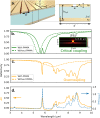Over-coupled resonator for broadband surface enhanced infrared absorption (SEIRA)
- PMID: 37558692
- PMCID: PMC10412556
- DOI: 10.1038/s41467-023-40511-7
Over-coupled resonator for broadband surface enhanced infrared absorption (SEIRA)
Abstract
Detection of molecules is a key issue for many applications. Surface enhanced infrared absorption (SEIRA) uses arrays of resonant nanoantennas with good quality factors which can be used to locally enhance the illumination of molecules. The technique has proved to be an effective tool to detect small amount of material. However, nanoresonators can detect molecules on a narrow bandwidth so that a set of resonators is necessary to identify a molecule fingerprint. Here, we introduce an alternative paradigm and use low quality factor resonators with large radiative losses (over-coupled resonators). The bandwidth enables to detect all absorption lines between 5 and 10 μm, reproducing the molecular absorption spectrum. Counterintuitively, despite a lower quality factor, the system sensitivity is improved and we report a reflectivity variation as large as one percent per nanometer of molecular layer of PMMA. This paves the way to specific identification of molecules. We illustrate the potential of the technique with the detection of the explosive precursor 2,4-dinitrotoluene (DNT). There is a fair agreement with electromagnetic simulations and we also introduce an analytic model of the SEIRA signal obtained in the over-coupling regime.
© 2023. Springer Nature Limited.
Conflict of interest statement
The authors declare no competing interests.
Figures





References
-
- Ng LM, Simmons R. Infrared spectroscopy. Anal. Chem. 1999;71:343–350. - PubMed
-
- Osawa, M.Surface-Enhanced Infrared Absorption, 163–187 (Springer Berlin Heidelberg, Berlin, Heidelberg, 2001).
-
- Hartstein A, Kirtley JR, Tsang JC. Enhancement of the infrared absorption from molecular monolayers with thin metal overlayers. Phys. Rev. Lett. 1980;45:201–204.
-
- Neubrech F, et al. Resonant plasmonic and vibrational coupling in a tailored nanoantenna for infrared detection. Phys. Rev. Lett. 2008;101:157403. - PubMed
-
- Cubukcu E, Zhang S, Park Y-S, Bartal G, Zhang X. Split ring resonator sensors for infrared detection of single molecular monolayers. Appl. Phys. Lett. 2009;95:043113.
Grants and funding
- ANR-20-CE39-0003/Agence Nationale de la Recherche (French National Research Agency)
- ANR-20-CE39-0003/Agence Nationale de la Recherche (French National Research Agency)
- ANR-20-CE39-0003/Agence Nationale de la Recherche (French National Research Agency)
- ANR-20-CE39-0003/Agence Nationale de la Recherche (French National Research Agency)
LinkOut - more resources
Full Text Sources

